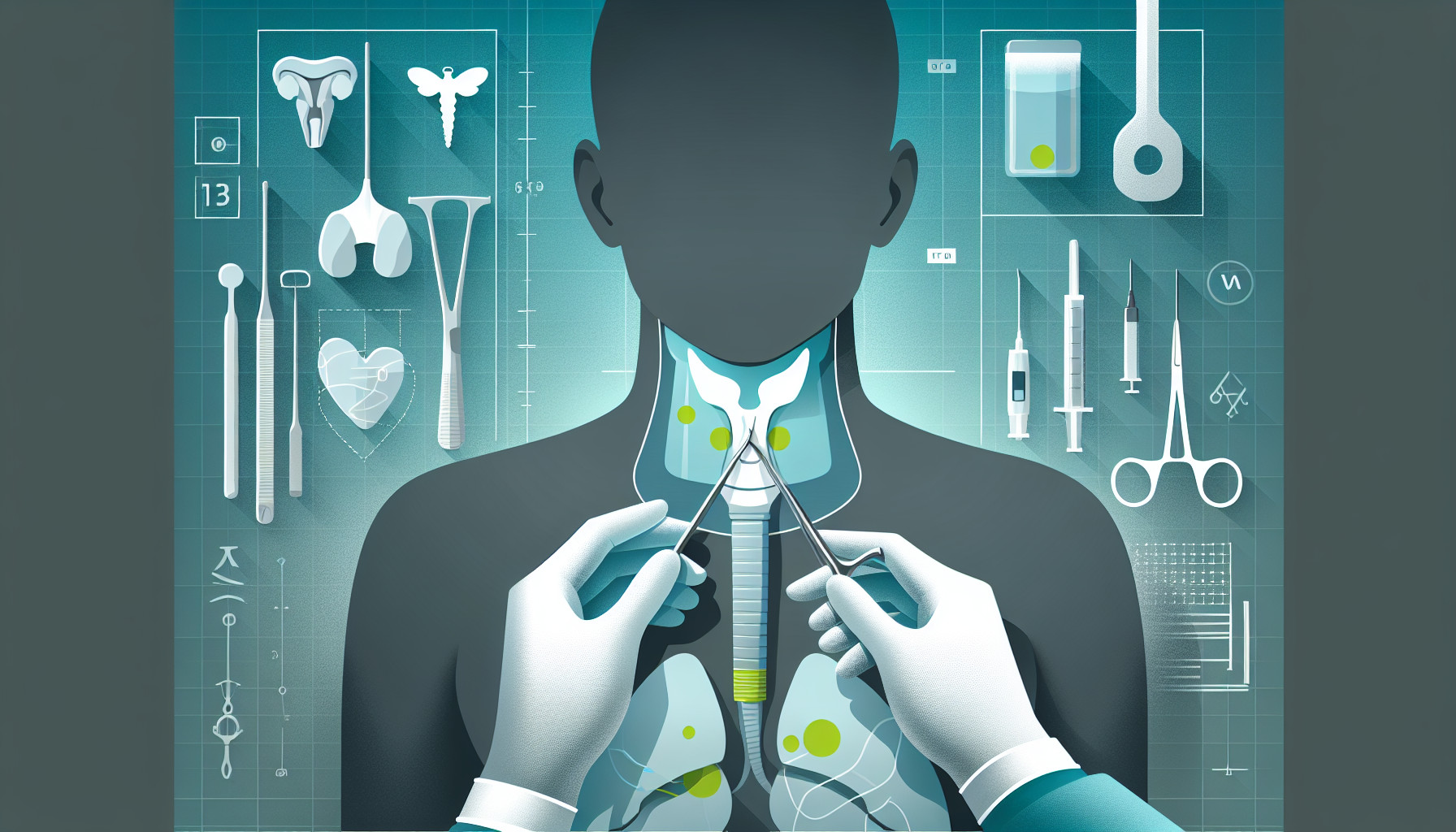Our Summary
This research paper is about a study comparing two methods of performing endoscopic thyroidectomy surgery: one that uses carbon dioxide (CO2) insufflation and one that doesn’t. The researchers designed a simple tool using a Kirschner wire that can lift the flap during the surgery, making it possible to perform the operation without CO2 insufflation.
The study involved a total of 42 patients who underwent endoscopic thyroidectomy. They were randomly assigned into two groups: 20 were operated using the gasless method with the Kirschner wire tool, and 22 using the conventional method with CO2 insufflation.
The researchers compared several factors between the two groups, including operating time, blood loss, complications, and hospital stay. They also monitored the patients’ heart rate, blood pressure, and oxygen levels during the surgery.
The results showed that the CO2 group had higher levels of carbon dioxide and lower levels of arterial pH during the operation, longer operation times, and higher endoscope clarity scores. However, there was no significant difference in hospital stay, drainage volume, and postoperative complications between the two groups.
In conclusion, the researchers found that performing endoscopic thyroidectomy without CO2 insufflation using their new Kirschner wire tool was safe, feasible, and gave good results.
FAQs
- What is the difference between the two methods of performing endoscopic thyroidectomy that were studied?
- What were the key findings of the study comparing CO2 insufflation and the gasless method in endoscopic thyroidectomy?
- How did the Kirschner wire tool impact the feasibility and safety of performing endoscopic thyroidectomy without CO2 insufflation?
Doctor’s Tip
A helpful tip a doctor might tell a patient about thyroidectomy is to follow post-operative care instructions carefully. This may include taking prescribed medications, attending follow-up appointments, monitoring for any signs of infection or complications, and following a specific diet or activity restrictions. It is also important to communicate any concerns or changes in symptoms to your healthcare provider promptly. Taking care of yourself after thyroid surgery can help ensure a smooth recovery and optimal outcomes.
Suitable For
Patients who are typically recommended for thyroidectomy surgery include those with:
Thyroid cancer: Patients with thyroid cancer may undergo thyroidectomy as part of their treatment plan to remove cancerous tissue.
Noncancerous thyroid nodules: Thyroid nodules that are causing symptoms such as difficulty swallowing or breathing may require thyroidectomy for removal.
Hyperthyroidism: Patients with hyperthyroidism, a condition in which the thyroid gland produces too much thyroid hormone, may undergo thyroidectomy to remove part or all of the thyroid gland.
Enlarged thyroid gland (goiter): A large goiter that is causing symptoms such as difficulty swallowing or breathing may require thyroidectomy for removal.
Recurrent thyroid nodules: Patients who have recurrent thyroid nodules that continue to grow or cause symptoms may require thyroidectomy for removal.
Graves’ disease: Patients with Graves’ disease, an autoimmune disorder that causes the thyroid gland to become overactive, may undergo thyroidectomy as a treatment option.
Overall, patients who are experiencing symptoms related to their thyroid condition or have been diagnosed with thyroid cancer or other thyroid disorders may be recommended for thyroidectomy surgery.
Timeline
Before the thyroidectomy:
- Patient consults with a healthcare provider and decides to undergo thyroidectomy surgery.
- Patient may undergo preoperative tests such as blood work, imaging studies, and thyroid function tests.
- Patient receives instructions on preoperative preparation such as fasting before surgery and stopping certain medications.
- Patient undergoes the thyroidectomy surgery, either with or without CO2 insufflation.
- Surgery is completed, and patient is monitored in the recovery room.
After the thyroidectomy:
- Patient is monitored for any immediate postoperative complications such as bleeding, infection, or adverse reactions to anesthesia.
- Patient may stay in the hospital for a few days for observation and recovery.
- Patient may experience symptoms such as pain, swelling, difficulty swallowing, and hoarseness in the days following surgery.
- Patient is discharged from the hospital and instructed on postoperative care, including wound care, pain management, and activity restrictions.
- Patient follows up with their healthcare provider for postoperative check-ups and monitoring of thyroid function.
- Patient may need to take thyroid hormone replacement medication for the rest of their life if their entire thyroid gland was removed during surgery.
What to Ask Your Doctor
- What exactly is a thyroidectomy and why is it necessary in my case?
- What are the potential risks and complications associated with a thyroidectomy procedure?
- How will the use of CO2 insufflation during the surgery impact my recovery and overall outcome?
- Are there any alternative methods or techniques that can be used instead of CO2 insufflation during the surgery?
- How experienced are you in performing thyroidectomy surgeries, especially using the gasless method with the Kirschner wire tool?
- What should I expect in terms of recovery time, pain management, and follow-up care after the surgery?
- Will I need to take any medications or make any lifestyle changes after the thyroidectomy?
- How will the results of this study impact your approach to my individual case and the decision-making process for my surgery?
- Are there any specific precautions or steps I should take before the surgery to ensure the best possible outcome?
- Can you provide me with any additional information or resources to help me better understand the procedure and what to expect?
Reference
Authors: Guo T, Wu Z, He J, Liu D, Wan H, Li Y, Peng S, Xu A. Journal: Front Endocrinol (Lausanne). 2022 Dec 23;13:1028805. doi: 10.3389/fendo.2022.1028805. eCollection 2022. PMID: 36619584
